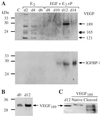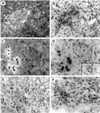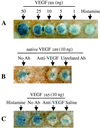A dynamic shift of VEGF isoforms with a transient and selective progesterone-induced expression of VEGF189 regulates angiogenesis and vascular permeability in human uterus
- PMID: 11972026
- PMCID: PMC122895
- DOI: 10.1073/pnas.082110999
A dynamic shift of VEGF isoforms with a transient and selective progesterone-induced expression of VEGF189 regulates angiogenesis and vascular permeability in human uterus
Abstract
A key mechanism underlying physiological angiogenesis of the human endometrium is its ability to regenerate the vascular capillary network and to perform vascular remodeling (i.e., development of spiral arteries). Vascular endothelial growth factor (VEGF) is associated with angiogenesis and capillary permeability in this tissue. VEGF is expressed as several spliced variants, its main human isoforms contain 121 and 165 aa; 17beta-estradiol (E(2)) increases endometrial VEGF, possibly in all isoforms. Here we show that progesterone (P) selectively increases the expression of the VEGF(189) (V(189)) isoform in the human uterus. V(189) is identified in the conditioned medium of stromal cells treated with E(2) + P; its presence in this in vitro model of decidual stromal cells is detected after 6-8 days, using ELISA, and after 8-10 days, using Western blot analysis with different antibodies, including one specific for V(189). The secretion pattern of V(189) parallels that of the decidual protein IGFBP-1. V(189) is secreted as a native isoform, as compared with the migration of recombinant V(189) by SDS/PAGE. In situ hybridization and immunocytochemistry(,) performed on the same biopsies, suggest that decidual cells express V(189) during the mid-late secretory phase of the menstrual cycle and early gestation. Finally, using an in vivo permeability assay, we show that native V(189) increases capillary permeability. These observations demonstrate that P regulates V(189) expression in decidual cells, which could have important implications for understanding uterine vascular remodeling and implantation, and may be relevant in a range of disease states such as edema and irregular bleeding.
Figures





References
-
- Giudice L. In: Reproductive Endocrinology, Surgery and Technology. Adashi E Y, Rock J A, Rosenwaks Z, editors. Philadelphia: Lippincott–Raven; 1996. pp. 272–300.
-
- Perrot-Applanat M. In: Encyclopedic Reference of Vascular Biology and Pathology. Bikfalvi A, editor. Berlin: Springer-Verlag; 2000. pp. 157–162.
-
- Charnock-Jones D S, Sharkey A M, Rajput-Williams J, Burch D, Schofield J P, Foutain S A, Boocock C A, Smith S K. Biol Reprod. 1993;48:1120–1128. - PubMed
-
- Zhang L, Rees M C P, Bicknell R. J Cell Sci. 1995;108:323–331. - PubMed
-
- Torry D S, Holt V J, Keenan J A, Harris G, Caulde M R, Torry R J. Fertil Steril. 1996;66:72–80. - PubMed
Publication types
MeSH terms
Substances
LinkOut - more resources
Full Text Sources
Molecular Biology Databases

